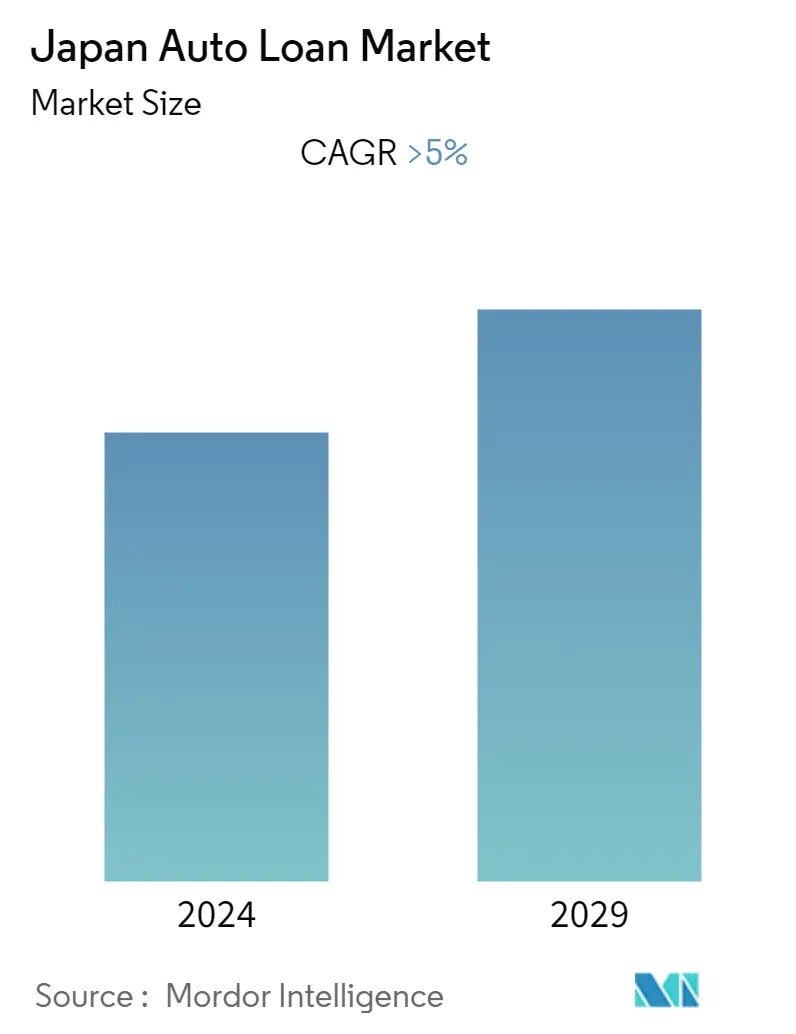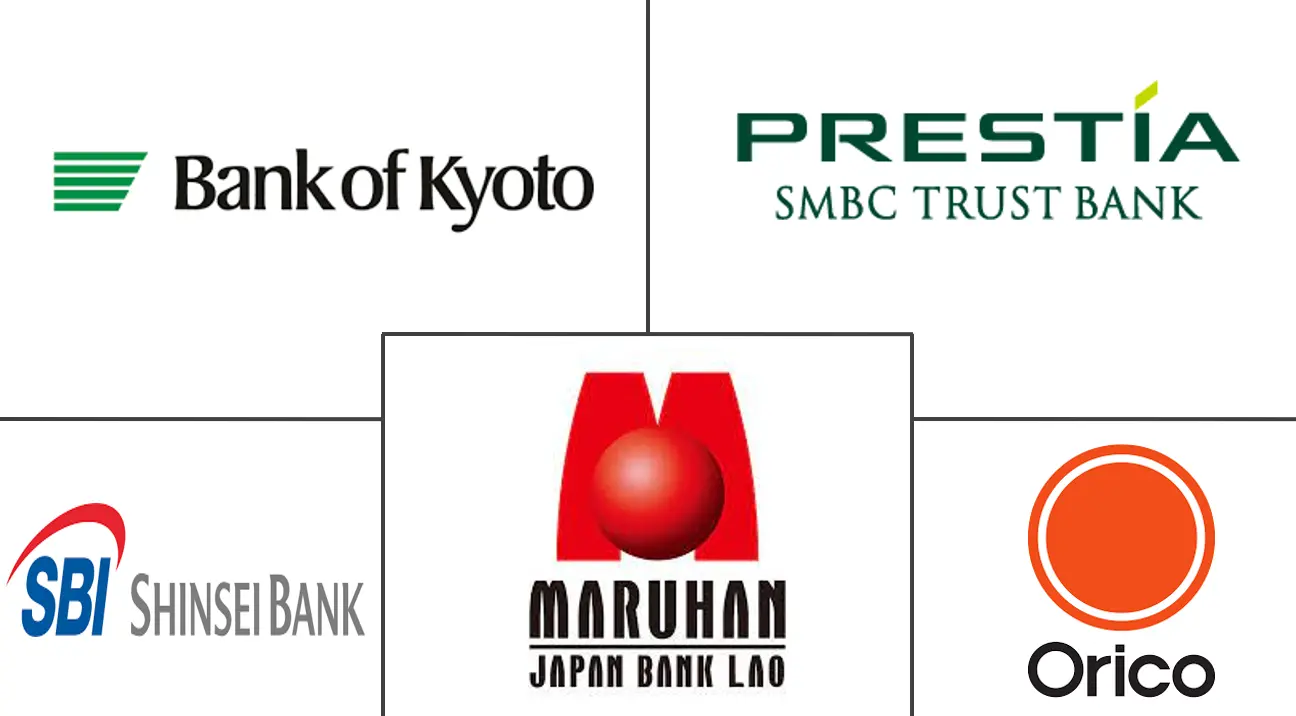Market Size of Japan Auto Loan Industry

| Study Period | 2020 - 2029 |
| Base Year For Estimation | 2023 |
| Forecast Data Period | 2024 - 2029 |
| Historical Data Period | 2020 - 2022 |
| CAGR | 5.00 % |
| Market Concentration | Medium |
Major Players
*Disclaimer: Major Players sorted in no particular order |
Japan Auto Loan Market Analysis
Japan's auto loan market has a loan outstanding of USD 8.67 billion in the current year and is poised to register a CAGR of more than 5% for the forecast period.
The value of outstanding loans in Japan has observed a continuous rise over the years, signifying an increase in the number of loan policies being taken, including auto loans as well. In the passenger vehicles segment of the country, medium cars and minivans have more share in market sales, leading to loan providers focusing on certain sections of the auto loan market. Sales of commercial vehicles in the country are observing a continuous decline post covid resulting in loan providers shifting toward passenger vehicles to increase their market share. Rise in the level of default rate, inflation with a decline in wage rate growth, and government support measures are among the factors negatively affecting the industry.
With an existing lower interest rate on loans in the country, loan providers are majorly focusing on the rising price of automobiles, which is resulting in customers opting for auto loans to finance their vehicles and increase the business of automobile loan providers. Automobile manufacturers are coming up with their own finance companies to make it simple for buyers to buy the car. Toyota, Suzuki, Daihatsu, Honda, and Nissan are existing as leading sellers in Japan having their own finance companies such as Toyota Financial Services, Nissan Financial Services, and others.
Nagano, Gunma, Ibaraki, and Tochigi are among the cities in Japan with a leading automobile share of more than 65% of their population. The share of passenger vehicles in the country increases with distance away from cities because of the availability of public transportation facilities in the cities and is leading to population segment away from cities emerging as potential buyers of auto loans in the market. Post-COVID-19, with the emerging market of electric vehicles, the government is providing subsidies on the cost of electric vehicles as their price is relatively higher than conventional vehicles and is leading to the creation of new business opportunities for auto loan providers.
Japan Auto Loan Industry Segmentation
An automobile loan allows a user to borrow money from a lender and use it to purchase different forms of vehicles, which include Passenger and commercial vehicles. The loan is paid back to the issuer in the form of installments over some time with an agreed amount of interest payment.
Japan's auto loan market is segmented by vehicle type (passenger vehicles, commercial vehicles), by ownership (new vehicles, used vehicles), by end-user (individuals, enterprises), and by loan provider (banks, OEMs, credit unions, and other loan providers).
The report offers market sizes and forecasts for the Japanese auto loan market in value (USD) for all the above segments.
| By Vehicle Type | |
| Passenger Vehicle | |
| Commercial Vehicle |
| By Vehicle Age | |
| New Vehicle | |
| Used Vehicle |
| By End User | |
| Individual | |
| Enterprise |
| By Loan Provider | |
| Banks | |
| OEM | |
| Credit Unions | |
| Other Loan Providers |
Japan Auto Loan Market Size Summary
The Japanese auto loan market is experiencing a steady growth trajectory, driven by an increasing number of loan policies and a focus on passenger vehicles, particularly medium cars and minivans. The market dynamics are shifting as loan providers pivot from commercial vehicles, which have seen a decline in sales post-COVID-19, to passenger vehicles to capture a larger market share. Despite challenges such as rising default rates and inflation, the market benefits from lower interest rates, encouraging consumers to finance their vehicle purchases through auto loans. The presence of automobile manufacturers like Toyota, Suzuki, and Honda, who have established their own finance companies, further supports the market's expansion. Additionally, government subsidies for electric vehicles are creating new opportunities for auto loan providers, as these vehicles become more accessible to consumers.
The competitive landscape of the Japanese auto loan market is becoming increasingly fragmented, with a growing number of participants including banks, fintech companies, and OEMs. This competition is driving the adoption of digital technologies, making it easier for consumers to compare and access various auto loan offers. The rise of digital banking has led to a significant increase in net interest income, prompting more lenders to offer their services online. This shift towards digitization is transforming the loan processing model, enhancing market reach and affordability for borrowers. Key players in the market, such as Maruhan Japan Bank and SBI Shinsei Bank, are leveraging these technological advancements to expand their market presence. Recent strategic acquisitions, like those by Sojitz Corporation and MUFG, highlight the ongoing efforts to strengthen and expand the auto loan business in Japan.
Japan Auto Loan Market Size - Table of Contents
-
1. MARKET DYNAMICS AND INSIGHTS
-
1.1 Market Overview
-
1.2 Market Drivers
-
1.2.1 Increase In Demand For Passenger Vehicles
-
1.2.2 Quick Processing of Loan through Digital Banking
-
-
1.3 Market Restraints
-
1.3.1 Rise of Interest Rates
-
-
1.4 Market Opportunities
-
1.4.1 Flexible Interest Rate by Financing Companies Raising their Loan Sales
-
1.4.2 Emerging Market of Electric Vehicles Expanding the Auto Loan Market
-
-
1.5 Industry Attractiveness - Porter's Five Forces Analysis
-
1.5.1 Bargaining Power of Suppliers
-
1.5.2 Bargaining Power of Buyers
-
1.5.3 Threat of New Entrants
-
1.5.4 Threat of Substitutes
-
1.5.5 Intensity of Competitive Rivalry
-
-
1.6 Technological Innovations in Japan Auto Loan Market
-
1.7 Impact of COVID-19 on the Market
-
-
2. MARKET SEGMENTATION
-
2.1 By Vehicle Type
-
2.1.1 Passenger Vehicle
-
2.1.2 Commercial Vehicle
-
-
2.2 By Vehicle Age
-
2.2.1 New Vehicle
-
2.2.2 Used Vehicle
-
-
2.3 By End User
-
2.3.1 Individual
-
2.3.2 Enterprise
-
-
2.4 By Loan Provider
-
2.4.1 Banks
-
2.4.2 OEM
-
2.4.3 Credit Unions
-
2.4.4 Other Loan Providers
-
-
Japan Auto Loan Market Size FAQs
What is the current undefined size?
The undefined is projected to register a CAGR of greater than 5% during the forecast period (2025-2030)
Who are the key players in undefined?
Maruhan Japan Bank, SMBC Trust Bank, Bank of Kyoto, Orient Corporation and SBI Shinsei Bank are the major companies operating in the undefined.

